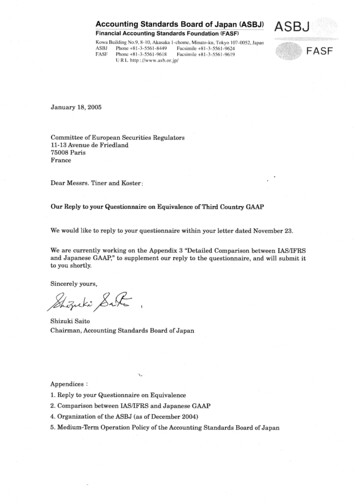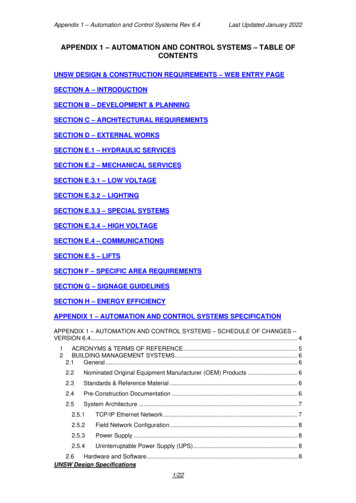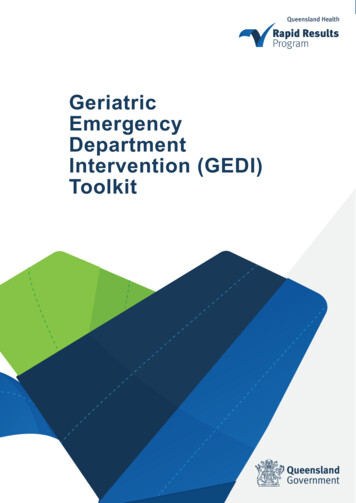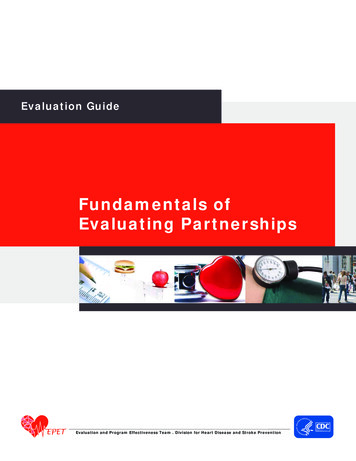
Transcription
Appendix 1Questionnair e on equivalence of thir d countr y GAAPSection 1 – Gener ally Accepted Accounting Pr inciplesa. Please describe the financial reporting standards that are legally enforceable in your jurisdiction asof January 2005, and which are covering the list of topics mentioned in Annex 2?The Japanese financial reporting standards legally enforceable to public companies, as of January2005 consist of the following:Securities and Exchange Law (the “SEL”), and its related regulationsAccounting Standards (issued by the Business Accounting Council (the “BAC”), anindependent body within the Financial Services Agency organised for accounting andauditing issues; and had been an accounting setter until the Accounting Standards Board ofJapan (the “ASBJ”) was established in July 2001.)Accounting standards, Guidance on Accounting Standards, and Reports of Practical IssuesTask Force (issued by the ASBJ, an independent private accounting setter)Practical Guidelines on Accounting Standards (issued by the Japanese Institute of CertifiedPublic Accountant (the “JICPA”), a statutory organisation of auditing practitioners, andhad prepared guidelines for Accounting Standards announced by the BAC, until the ASBJwas established in July 2001.)These financial reporting standards are organised in Appendix 2 to be correspondent with eachstandard under IAS/IFRS, and if clearly corresponding standard for each IAS/IFRS is not applicableunder Japanese GAAP, reasons are provided under “Remarks” column in the appendix, together withthe brief comparison between IAS/IFRS and Japanese GAAP. The detailed comparison betweenIAS/IFRS and Japanese GAAP are summarised in Appendix 3.The Commercial Code and its related accounting regulations govern all joint-stock companies inJapan. The Commercial Code requires all joint-stock companies (including public companies) toprepare non-consolidated financial statements based on the Commercial Code, and discloseconsolidated financial statements prepared under the SEL; whereas the SEL requires public companiesto prepare both consolidated and non-consolidated financial statements, and recognizes consolidated1
Appendix 1financial statements as primary financial statements, and non-consolidated financial statements assecondary financial statements.In addition, Accounting Standards for Consolidated FinancialStatements and Regulations for Presentation and Disclosure of Consolidated Financial Statementsrequire that consolidated financial statements shall be prepared based on the non-consolidatedfinancial statements.Therefore, in the process of preparing non-consolidated financial statements,the regulations under the SEL and the Commercial Code co-relate each other.b. Where relevant, please also describe any other principles/guidance which are not mandatoryapplicable but are relevant for this project.There are several research reports issued by the JICPA which discuss accounting treatments forspin-offs and exchange of shares. These research reports are widely referred in current practice,although they are not mandatory. However, they will be replaced, when new accounting statements(i.e. Accounting Standards for Spin-offs, and Guidance of Accounting Standards for BusinessCombinations and Spin-offs, which are currently under discussion) are developed by the ASBJ.c. Could you please include a description of the formal hierarchy of your standards? In particular,indicate whether the financial reporting standards referred to above are e.g. accounting standards,company law provisions, and corporate governance standards.Please also state whether provisionsreferred to are standards or interpretation (where necessary, please mention the basis for theenforceability).The following illustrates our formal hierarchies of accounting standards, and related governing laws.I.Gener ally accepted accounting pr inciples in J apan (J apanese GAAP)Japanese GAAP are categorized by the following hierarchy.1Accounting Standards (issued by the BAC or the ASBJ)2Guidance on Accounting Standards and Reports of Practical Issues Task Force(issued by the ASBJ)3Practical Guidelines on Accounting Standards and Q&As (issued by the JICPA)4Generally accepted accounting practicesAccounting Standards are standards, and others are their interpretations.2
Appendix 1II.Applicable law and r egulations for public companiesThe following laws and regulations primarily govern the financial reporting of public companies.The SELRegulations for Presentation and Disclosure of Consolidated Financial Statements,Financial Statements, Semi-Annual Consolidated Financial Statements, and Semi-AnnualFinancial Statements (collectively referred as “Regulations for presentation and disclosureof financial statements”)The Financial Services Agency (“FSA”) is responsible for these laws, regulations, and rules. Inaddition, the Commercial Code and its related provisions (i.e. the Commercial Code, and its relatedlaws and detailed regulations) are applied to preparation of non-consolidated financial statements, andthe Ministry of Justice is responsible for the Commercial Code and its related provisions.Accounting standards are enforceable under the SEL, since it is explicitly stated under the Regulationsfor presentation and disclosure of financial statements that in preparing consolidated andnon-consolidated financial statements, generally accepted accounting principles shall be followed. Inaddition, there is a provision under the Commercial Code that fair accounting practices should beconsidered for the interpretation of provisions in preparing non-consolidated financial statements.Accounting standards issued by the BAC are treated as generally accepted accounting principles underthe Regulations for presentation and disclosure of financial statements.The FSA issues notices for accounting standards issued by the ASBJ that these standards shall betreated as part of generally accepted accounting principles.In addition, the AccountingStandards, Guidance on Accounting Standards, and Reports of Practical Issues Task Forcepronounced by the ASBJ were confirmed to be part of GAAP by the following nine foundationsparties (i.e. Japan Business Federation, the JICPA, the National Conference of Stock Exchanges,Japan Securities Dealers Association, Japanese Bankers Association, the Life InsuranceAssociation of Japan, the General Insurance Association of Japan, the Japan Chamber ofCommerce and Industry, and the Security Analysts Association of Japan).3
Appendix 1d. Please indicate whether there are any additional or different enforceable final standards whose dateof application would be after 1st January 2005.Following standards have been already approved and published by the BAC, and shall be effectiveafter January 2005.Accounting Standards for Impairment of Assets (published in August 2002, and shall beeffective for the fiscal periods beginning on or after April 2005.Early adoption ispermitted, and these standards have been already widely applied by many listedcompanies.)Accounting Standards for Business Combinations (published in October 2003, and shall beeffective for the fiscal periods beginning on or after April 2006)e. Do you anticipate other significant changes in your GAAP to take place before 1st January 2007(date upon which all third country issuers in Europe will have to present financial statements preparedunder IAS/IFRS or equivalent GAAP, for reporting under Transparency and Prospectus EUDirective)?Accounting Standards for Share-based Payments and Accounting Standards for Spin-offs are currentlyunder deliberation by the ASBJ, and the Exposure Draft on Accounting Standards for Share-basedPayments was published in December 2004. In addition, change in Accounting Standards for Leasesis currently under deliberation.Further, several topics, which will be in the scope of the first phase of the joint project between theASBJ and the IASB (please see section 7 for detail) are expected to be developed or revised by theend of 2006, if deliberations proceed smoothly.4
Appendix 1Section 2- Descr iption of differ encesa. Please describe any differences between your financial reporting standards and the IAS/IFRS listedin Appendix 2 (please indicate which of your national financial reporting standards correspond to eachIAS/IFRS mentioned).Differences should be mentioned with regard to the following types of nDisclosurePlease find Appendix 2 and 3 for reference of comparison between Japanese GAAP and IAS/IFRS.In order to make tables more understandable, the overview is provided under Appendix 2, and detailedanalysis are provided under Appendix 3.b. When information is provided to investors through other means than in the financial statements; isthis information subject to audit requirements identical to those applicable for financial statements?Information other than financial statements that are included in legal disclosure documents is notsubject to audit requirements, applicable for financial statements.However, in practices,independent auditors read these information as part of professional due care, noting any significantinconsistencies between the financial statements and other information. If any significant differencesare noted, these differences shall be stated in the explanatory paragraph of the independent auditors’reports, as required by auditing standards and its implementation guidance.From April 2004, quarterly financial information requirements have been introduced to listedcompanies of the first and the second section at Tokyo Stock Exchange (“TSE”), and the disclosure ofquarterly financial statements will be mandatory beginning April 2007 at TSE, and the review of suchquarterly financial statements by independent auditors is performed on discretionary basis.Furthermore, the requirements for disclosure of quarterly financial information under the SEL, andalso the need for assurance of quarterly financial statements are under deliberation at the DisclosureWorking Group of Financial System Council, an independent body established for disclosure issueswithin the FSA.In addition, accounting-related descriptions in the Business Reports under the Commercial Code5
Appendix 1which are to be distributed to shareholders shall be audited, and therefore audit opinions are givento such accounting-related descriptions in the Business Reports together with the financialstatements.Section 3 – Standar d Setting Pr ocessa. What is(are) the name of the body(ies) entrusted with the standard setting process in yourjurisdiction? Please detail structure, functions and responsibilities of theses bodies.The ASBJ, which was established in July 2001 as a private-sector organisation in the FinancialAccounting Standards Foundation (FASF), is responsible for setting Japanese accounting standardsand contributing to the development of international accounting standards, and all Japaneseaccounting standards whose deliberations started after its foundation in July 2001 have beendeveloped by the ASBJ.The ASBJ consists of thirteen board members (two of them work full-time) and twenty technical staff(all full-time). The Board members consist of market participants such as investors, preparers,auditors, and analysts, as well as academics. In addition, the Board sets up Technical Committees(“TC”) for respective major agendas and entrusts the TC for research and deliberation of technicalmatters. The TC consist of some board members, market participants, academics, and the ASBJ’stechnical staffs.The ASBJ has been developing accounting standards under the fundamental philosophies of“fairness,” “transparency” and “independence,” considering international accounting standards as animportant external factor. These principles are stated in the Medium-Term Operating Policy of theASBJ formulated in July 2004 as a basic principle for the development of accounting standards.(Note)Please see Appendix 4 “Organisation chart of the ASBJ” and Appendix 5 “ Medium-term operating policyof the ASBJ.”6
Appendix 1b. Please include a brief description of the standard setting process (of the standards referred toabove).The following summarizes brief descriptions of the standard setting process in Japan.The Board determines subjects to be deliberated, considering the proposals by the ThemeAdvisory Council within the FASF.The Board, in principle, sets up TC for each agenda. The Board and TC discuss eachagenda with its discussion open to public observation, and the TC draft up Issue Papers (ifnecessary) and Exposure Drafts, in order to consider opinions from public includingmarket participants.These papers and drafts need to be approved by the Board beforethey are issued, and public comments on them are invited for more than one month.Drafts of Accounting Standards, Guidance on Accounting Standards and Reports ofPractical Issues Task Force are revised as final draft by the TC after they analyse thecomments received, and are finalised by the Board through further deliberations. Thesefinalised versions are made to public immediately after the resolution by the Board.Resolution by the Board should be made with votes of three-fifth of the members or more.The FSA issues notices that these Accounting Standards shall be treated as a part ofgenerally accepted accounting principles.c. Are the standards referred to above easily accessible in English?Following are available for our accounting standards as easily accessible resources in English.“FASF Japanese Accounting Standards” (issued by the FASF)The contents of this resource are Accounting Standards developed or revised from 1993 to 2000,which includes Accounting Standards for Consolidated Financial Statements, ConsolidatedStatement of Cash Flows, Foreign Exchange Transactions, Leases, Semi-annual ConsolidatedFinancial Statements, Research and Development Costs, Retirement Benefits, Income Taxes, andFinancial Instruments), and their related Practical Guidelines issued by the JICPA.Thisresource is available by CD-Rom.”Corporate Disclosure in Japan – Accounting” (issued by the JICPA)This was prepared for the purpose of presenting Japanese accounting standards as of 1999, and7
Appendix 1Business Enterprise Accounting Standards was included.(Note) Most of our current major accounting standards are included in the resource above, althoughAccounting Standards developed after 2000 (Accounting Standards for Impairment of Assets, BusinessCombinations, Treasury Stock, and Earnings Per Share) are not covered by them.Section 4 – Conceptual fr amewor ka. Do you have general financial reporting principles identical to the ones set out in the IAS/IFRSframework? Please describe any difference.The ASBJ released a discussion paper “Conceptual Framework of Financial Reporting” in September2004. This was the result of a study by a working group commissioned by the Board, and wasreleased in the name of the ASBJ.This is not a final statement but summarises the basicphilosophies underlying current Japanese accounting standards, and therefore we consider it useful forunderstanding current Japanese accounting standards.The discussion paper consists of “Objectives of Financial Reporting”, “Qualitative Characteristics ofAccounting Information”, “Elements of Financial Statements”, and “Recognition and Measurement inFinancial Statements.”In the “Objectives of Financial Reporting” section of the discussion paper,the primary objective of financial reporting is defined to provide investors with information that isuseful for investors’ decision-making, which is consistent with the IAS/IFRS Framework.In addition, in “Elements of Financial Statements” section, “comprehensive income” which is derivedfrom the concept of assets and liabilities is defined as an element, and “net income” which is acomponent of items of comprehensive income, and similar to “earnings” stated in FASB Statement ofConcepts No.5, is defined as an element, as well.b. Are your enforceable financial reporting standards taking into account the four characteristics asdescribed in the concept paper released by CESR? Where not the case, please explain the differences.The four characteristics described in the concept paper released by CESR (i.e. Relevance, Reliability,Comparability, and Understandability) have been taken into account in development and improvementof financial accounting standards in Japan.8
Appendix 1Our discussion paper “Conceptual Framework of Financial Reporting” takes these four characteristicsinto consideration, and, as a result of organizing these discussions, Relevance and Reliability areplaced at the highest level. Comparability (i.e. the concept that comparability among differententities and different time-series can be accomplished if similar facts are converted into similarinformation) is considered to be under the concept of Representational Faithfulness (i.e. the conceptthat different accounting treatment shall be applied to different facts, and consistent accountingtreatments shall be applied to same facts), which is the lower-level characteristics that supportReliability.While Understandability is also considered to be important, it is explained as aself-evident characteristic in describing the premise in our discussion paper that financial reporting isconsidered to be provided for sophisticated investors in certain level.c. Do financial statements prepared under the basis of your GAAP pursue the same objectives asfinancial statements prepared under IAS/IFRS?The purpose of the SEL is to accomplish the fairness in issuance, trading and other transactions ofsecurities related transactions, in order to protect investors.For that purpose, public companies arerequired to disclose financial reporting mainly on consolidated basis.Therefore, the primary objective of financial reporting which is a measure to accomplish the ultimateobjective above is to provide investors with information that is useful in anticipating future cash flowsof entities, in other words, information useful in expecting performance of entities, and estimatingvalues of entities. This objective of financial reporting is consistent with that under IAS/IFRSframework which defines the objective of financial statements to provide information about thefinancial position, performance and changes in financial position of entities that is useful to a widerange of users in making economic decisions.Accordingly, financial statements prepared under the basis of Japanese GAAP pursue the sameobjective with financial statements prepared under IAS/IFRS.This discussion is explicitly stated under “Objectives of Financial Reporting” in the discussion paperabove.9
Appendix 1Section 5 -Published compar isonHave you conducted and published any exercise comparing and describing differences betweenIAS/IFRS and your country GAAP? If so, please provide us with a copy.Please also mention any other similar analysis that would have been made by a separate reliable bodyThe ASBJ is preparing the materials showing comparison between Japanese GAAP and IAS/IFRS touse for the joint project with the IASB (please see Section 7), which is almost similar to Appendix 3.Following materials were published to discuss the comparison between IAS/IFRS and JapaneseGAAP by reliable bodies.“Evolving Japanese GAAP – High quality accounting standards” (issued by the FSA, April2004)“Report on the Internationalization of Business Accounting in Japan” (issued by StudyGroup on the Internationalization of Business Accounting under Ministry of Economy,Trade and Industry, June 2004)Section 6 -Standar ds not covered by IAS/IFRSAre there standards/principles covered by your GAAP that are not covered by IAS/IFRS? If so, (i) dothey comply with IAS/IFRS basic principles contained in the IAS Framework and IAS 1 and (ii) arethey compatible with all other IAS/IFRS endorsed for use in the EU?There are several detailed accounting rules in accordance with Japanese legal system. For example,there is an accounting standard for employees’ pension fund plans based on the Welfare PensionInsurance Law, which is not specifically covered by IAS/IFRS. However, it seems that this standarddoes not contradict with basic principles of IAS/IFRS, and is compatible with all other IAS/IFRSendorsed for use in the EU.Section 7 Conver gence pr ojectsIs it intended that there will be any convergence project of your country’s national standards withIAS/IFRS or with another framework -? If so, please describe the project.In October 2004, the ASBJ and the IASB started talks about a joint project to reduce differencesbetween Japanese GAAP and IAS/IFRS towards a final goal of convergence of their standards. Inthe joint project, both boards will identify and assess differences in their existing standards on thebasis of their respective conceptual frameworks or basic philosophies, and adopt a phased approach.10
Appendix 1The ASBJ will propose the topics for the scope of the first phase shortly. An initial meeting betweenrepresentatives of the two Boards will take place in Tokyo in early spring of 2005.Since deliberations of some topics within the scope of the first phase are expected to be completed bythe end of 2006 if the deliberations proceed smoothly, we hope that CESR would take them intoconsideration in the technical assessment.Section 8 Other issuesIn understanding this exercise at this stage, do you identify any other particular issue that might berelevant for your national issuers in EU?N/A11
Appendix 2Comparison between IAS/IFRS and Japanese GAAPIAS and IFRS IssuedIFRS 1 First-time Adoption ofN/AInternational Financial ReportingStandardsList of Japanese GAAPScopePresentation/MeasurementRecognitionIFRS 2 Share-based PaymentReports of Practical Issue Task Force on Accountingfor New Share Reservation Rights and CorporateBonds with New Share Reservation RightsPlease see Appendix 3 for detailPlease see Appendix 3 for detailIFRS 3 Business CombinationsAccounting Standards for Business CombinationsPlease see Appendix 3 for detailUnder Japanese GAAP, the purchase method shall beapplied to accounting for business combinations inprinciple; while the pooling-of-interest method shall beapplied in exceptionally limited cases. Also, goodwillshall be amortised with impairment.Please see Appendix 3 for more details.IFRS 4 Insurance ContractsInsurance Business LawDisclosureRemarksThere is no need for this standard under Japanese GAAP, sincethis standard only addresses the first year application of IFRS.Please see Appendix 3 Under Japanese GAAP, accounting standards for share-basedfor detailpayment is currently under deliberation, and the exposure draftwhich requires fair value measurement of share-based payments agrant date, was issued by ASBJ in December 2004.Under Japanese GAAP, the pooling-of-interest method shall beapplied for the business combination in exceptionally limited casewhere no party obtains control over the other upon businesscombinations and thus shareholders’ interests in entities are notdiscontinued thereon, and it is expected that this will be appliedonly in exceptional cases.Under Japanese GAAP, goodwill shall be amortised with regularimpairment tests.Please see Appendix 3 for detailJICPA Guidelines for Tentative Treatments ofAccounting and Audit for "Debt SecuritiesEarmarked for Policy Reserve" in InsuranceCompaniesIFRS 5 Non-current Assets Held for Sale Accounting Standards for Impairment of Assetsand Discontinued OperationsIAS 1 Presentation of FinancialStatementsBusiness Enterprise Accounting StandardsPlease see Appendix 3 for detailPlease see Appendix 3for detailPlease see Appendix 3 for detailPlease see Appendix 3for detailRegulations for Presentation and Disclosure ofConsolidated Financial StatementsIAS 2 InventoriesBusiness Enterprise Accounting StandardsIAS 7 Cash Flow StatementsAccounting Standards for Preparing ConsolidatedStatements of Cash FlowsIAS 8 Accounting Policies, Changes inAccounting Estimates and ErrorsAccounting Standards for Consolidated FinancialStatementsRegulations for Presentation and Disclosure ofConsolidated Financial StatementsIAS 10 Events After the Balance SheetDatePlease see Appendix 3 for detailIAS requires changes in accounting policies bereflected retrospectively, while Japanese GAAPrequires them to be applied prospectively.Please see Appendix 3 for more detail.Since the resulting effect from change in accounting policies shallbe disclosed in the footnote under Japanese GAAP, thecomparability is maintained.Accounting Standards for Consolidated FinancialStatementsRegulations for Presentation and Disclosure ofConsolidated Financial StatementsIAS 11 Construction ContractsBusiness Enterprise Accounting StandardsIAS 12 Income TaxesAccounting Standards for Income TaxesIAS 14 Segment ReportingDisclosure Standards for Segment InformationRegulations for Presentation and Disclosure ofConsolidated Financial StatementsPlease see Appendix 3 for detailPlease see Appendix 3 for detailPlease see Appendix 3for detail
Appendix 2Comparison between IAS/IFRS and Japanese GAAPIAS and IFRS IssuedIAS 16 Property, Plant and EquipmentList of Japanese GAAPBusiness Enterprise Accounting StandardsScopePresentation/MeasurementPlease see Appendix 3 for detailRecognitionDisclosureRemarksJICPA Guidelines for Treatments for Property, Plantand EquipmentRegulations for Presentation and Disclosure ofConsolidated Financial StatementsIAS 17 LeasesAccounting Standards for LeasesIAS 18 RevenueBusiness Enterprise Accounting StandardsIAS 19 Employee BenefitsAccounting Standards for Retirement BenefitsUnder Japanese GAAP, finance lease transactionswithout title transfer shall be capitalised by lessee inprinciple. In addition, they may be accounted for inthe same manner under operating leases, ifcapitalised information is provided in the notes ofconsolidated financial statements. Please seeAppendix 3 for more detail.Please see Appendix 3 for detailUnder IAS, the corridor approach shall be applied to Please see Appendix 3 for detailamortisation of unrecognised actuarial gains andlosses, while actuarial gains and losses are strictlyamortised under Japanese GAAP.Please see Appendix 3 for more details.IAS 20 Accounting for Government Grants Business Enterprise Accounting Standardsand Disclosure of GovernmentAssistanceJICPA Guideline for Gains on Exchange Transactionand Government Grants when They Directly ReduceCarrying Amounts of Fixed AssetsPlease see Appendix 3 for detailIAS 21 The Effects of Changes in Foreign Accounting Standards for Foreign ExchangeExchange RatesTransactionsPlease see Appendix 3 for detailIAS 23 Borrowing CostsJICPA Guideline for Capitalization of InterestExpenses for Real Estate DevelopersIAS 24 Related Party DisclosuresJICPA Guideline for Treatment for Disclosure ofInformation of Related Party TransactionEven when finance leases without title transfers are accounted forin the same manner under operating leases, capitalised informationis provided in the notes of consolidated financial statements.Change in Accounting Standards for Leases is currently underdeliberation.Please see Appendix 3 for detailPlease see Appendix3 for detailPlease see Appendix 3for detailPlease see Appendix 3for detailRegulations for Presentation and Disclosure ofConsolidated Financial StatementsIAS 26 Accounting and Reporting byRetirement Benefit PlansN/AIAS 26 is not applicable to business enterprises.IAS 27 Consolidated and SeparateFinancial StatementsAccounting Standards for Consolidated FinancialStatementsIAS 28 Investments in AssociatesAccounting Standards for Consolidated FinancialStatementsIAS 29 Financial Reporting inHyperinflationary EconomiesN/AConsidering current economic situations of companies usingJapanese accounting standard, there is no urgent need for addingthis issue to our standard.IAS 30 Disclosures in the FinancialStatements of Banks and SimilarFinancial InstitutionsBanking LawBanking Law requires extensive disclosure for banking industryincluding disclosure requirements.Please see Appendix Minority interest shall be presented in equity under Please see Appendix 3 for detail3 for detailIAS, while Japanese GAAP requires it to bepresented as under an independent caption betweenliabilities and equity. Please see Appendix 3 formore details.Minority interest is presented under the caption between liabilityand equity in accordance with Japanese GAAP, since minorityinterest is not considered as parent company's interest.Presentation of minority interest under Japanese GAAP isconsistent with the current practical treatment in the US.
Appendix 2Comparison between IAS/IFRS and Japanese GAAPIAS and IFRS IssuedIAS 31 Interests in Joint VenturesList of Japanese GAAPAccounting Standards for Consolidated ease see Appendix 3 for detailRecognitionDisclosureRemarksProportional consolidation may be applied for interests in jointventures as an alternative for equity method under IAS 31, whileJapanese GAAP mandate equity method in all the case.Accounting Standards for Business CombinationsIAS 32 Financial Instruments: Disclosure Accounting Standards for Financial Instrumentsand PresentationIAS 33 Earnings per ShareAccounting Standards for Computation of EarningsPer ShareIAS 34 Interim Financial ReportingAccounting Standards for Semi-annual ConsolidatedFinancial Statements.Please see Appendix 3 for detailPlease see Appendix 3for detailRegulations for Presentation and Disclosure of Semiannual Consolidated Financial StatementsIAS 36 Impairment of AssetsAccounting Standards for Impairment of AssetsPlease see Appendix 3 for detailUnder IAS, impairments shall be recognised when thecarrying value of assets exceeds its recoverable amount,while Japanese GAAP requires assets to be impairedwhen the carrying value of assets exceeds its assessmentof undiscounted cash flows.In addition, reversal of impairment loss shall be
Japanese GAAP are categorized by the following hierarchy. 1 Accounting Standards (issued by the BAC or the ASBJ) 2 Guidance on Accounting Standards and Reports of Practical Issues Task Force (issued by the ASBJ) 3 Practical Guidelines on Accounting Standards and Q&As (issued by the JICPA) 4 Generally accepted accounting practices











